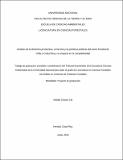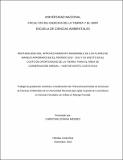| dc.contributor.advisor | Zamora Cervantes, Nancy | |
| dc.contributor.author | Acuña González, María José | |
| dc.date.accessioned | 2023-04-21T20:43:43Z | |
| dc.date.available | 2023-04-21T20:43:43Z | |
| dc.date.issued | 2022 | |
| dc.identifier.uri | http://hdl.handle.net/11056/25220 | |
| dc.description | Licenciatura Ingeniería en Ciencias Forestales con Énfasis en Manejo Forestal | es_ES |
| dc.description.abstract | Tras 52 años de legislación en materia forestal en Costa Rica y 20 años de la creación
del Plan Nacional de Desarrollo Forestal (PNDF), como instrumento de implementación de
política pública del sector, es imperante discutir cuál ha sido el alcance de dichos
instrumentos, así como su enfoque a futuro. Para el 2020, año de finalización de la vigencia
del segundo PNDF 2011-2020, diversas problemáticas del sector forestal persistían o se
habían agravado tras una década de esfuerzos. Esto conlleva a la necesidad de cuestionar si el
PNDF 2011-2020 ha permitido la implementación de las políticas forestales, el alcance de las
metas propuestas y si este documento se le ha dado el seguimiento y control de manera que
permita la toma de decisiones públicas que beneficien el sector forestal.
El presente documento, busca examinar la congruencia entre el PNDF 2011-2020 y la
política forestal, analizar sus indicadores y metas, determinar el nivel de cumplimiento y
realizar propuestas de mejora. Para esto, se realizó un análisis de fuentes bibliográficas, así
como el propio documento del PNDF 2011-2020 y su Matriz de Ajuste. Asimismo, se
realizaron entrevistas con personas expertas en política forestal, representantes de
instituciones y organizaciones forestales, gubernamentales y no gubernamentales, productores
forestales e industriales de la madera.
Como resultados del análisis político, se obtiene una recapitulación histórica de la
política forestal costarricense a través de las diferentes leyes, instrumentos e hitos relevantes.
En esta se denota como la legislación forestal inicia desde 1969, como respuesta al desarrollo
rural; sin embargo, no es hasta el 2000 que se logra formalizar una política forestal con un
instrumento de planificación sectorial correspondiente. La falta de una estrategia política
consensuada ha llevado a la toma de decisiones basadas en políticas implícitas personales, lo
cual ha conllevado a aciertos y desaciertos para el sector.
Asimismo, se analiza el rumbo y la pertinencia de la política oficial vigente y su
implementación, denotando las diferencias entre la ejecución (direccionada a la preservación)
y la teoría (enfocada a la producción), lo cual ha limitado el alcance de dicha política. Se
concluye que, para la ejecución adecuada de la política forestal, es necesario el apoyo de una
institucionalidad forestal cohesionada, así como de la totalidad del poder ejecutivo. Además,
es imprescindible lograr una concordancia de la política forestal con los instrumentos de
política país y planificación en los diferentes niveles de las instituciones públicas. Por otra parte, se encuentra que en el PNDF 2011-2020 las características de los
indicadores y metas dificultan la ejecución y seguimiento del documento. Para el PNDF, solo
un 49% de los indicadores y un 5,6% de las metas presentaron todas las características
descritas por este estudio como deseables, mientras estos porcentajes para la Matriz de Ajuste
corresponden a 48,7 y 35,9% respectivamente.
En cuanto a la implementación del PNDF, se realiza una revisión de los avances y rezagos de
cada eje temático. De dicha revisión se concluye que el eje más rezagado es el referente a
competitividad, destacando temas como altos costos de producción, falta de alternativas
tecnológicas, producción de poco valor agregado y alta competencia con productos sustitutos
y madera importada. Por otra parte, el eje referente a cambio climático fue considerado el más
avanzado, argumentando que se le ha dado gran énfasis a la implementación del programa
REDD+, al mismo tiempo que se ha promovido la cobertura forestal como medida ante el
cambio climático, generando reconocimiento internacional y el acceso a fondos de
cooperación.
A lo largo de la implementación del PNDF, se considera que ha existido una falta de
comunicación hacia la sociedad, con un enfoque dirigido a la protección, además de baja
articulación por parte de las instituciones forestales a la hora de llevar a cabo acciones
directas. Adicionalmente, existe un consenso en que no se ha realizado un seguimiento de la
ejecución de las políticas forestales o el PNDF.
Finalmente se realiza un análisis de las principales fortalezas y debilidades a trabajar a
futuro por el sector forestal. Estas son agrupadas en temáticas: protección; competitividad;
posicionamiento en el mercado; participación social; e institucionalidad. Para cada una de
estas áreas temáticas se realiza una sugerencia de indicadores que están siendo medidos
actualmente, con el fin de facilitar su seguimiento.
Mediante este proceso se finaliza el análisis del PNDF 2011-2020 y su articulación
con la política forestal costarricense; el cual permite concluir que frente a un nuevo periodo de
planificación, el sector necesita un instrumento de política claro y visionario. Asimismo, para
llevar a cabo lo planteado es fundamental contar con una institucionalidad comprometida con
la visión planteada, así como con el apoyo del resto del poder ejecutivo. | es_ES |
| dc.description.abstract | After 52 years of forestry legislation in Costa Rica and 20 years since the creation of the National Forestry Development Plan (PNDF) as an instrument for implementing public policy in the sector, it is imperative to discuss the scope of these instruments, as well as their future approach. By 2020, the year in which the second PNDF 2011-2020 came to an end, several problems in the forestry sector persisted or had worsened after a decade of efforts. This leads to the need to question whether the PNDF 2011-2020 has allowed the implementation of forest policies, the achievement of the proposed goals and whether this document has been monitored and controlled in a way that allows public decisions to be made that benefit the forestry sector. This document seeks to examine the consistency between the PNDF 2011-2020 and the forest policy, analyze its indicators and goals, determine the level of compliance and make proposals for improvement. For this purpose, an analysis of bibliographic sources was carried out, as well as the PNDF 2011-2020 document itself and its Adjustment Matrix. Interviews were also conducted with experts in forest policy, representatives of governmental and non-governmental forestry institutions and organizations, forest producers and timber industrialists. As a result of the policy analysis, a historical recapitulation of Costa Rican forestry policy is obtained through the different laws, instruments and relevant milestones. This document shows how forestry legislation began in 1969 as a response to rural development; however, it was not until 2000 that a forestry policy was formalized with a corresponding sectoral planning instrument. The lack of a consensual political strategy has led to decisions based on implicit personal policies, which has led to successes and failures for the sector. Likewise, the direction and relevance of the current official policy and its implementation are analyzed, noting the differences between execution (focused on preservation) and theory (focused on production), which has limited the scope of the policy. It is concluded that, for the adequate execution of the forest policy, it is necessary to have the support of a cohesive forestry institutional framework, as well as the support of the entire executive branch. In addition, it is essential to align forest policy with the country's policy and planning instruments at the different levels of public institutions. On the other hand, the characteristics of the indicators and goals in the PNDF 2011-2020 make it difficult to implement and monitor the document. For the PNDF, only 49% of the indicators and 5.6% of the targets presented all the characteristics described by this study as desirable, while these percentages for the Adjustment Matrix correspond to 48.7% and 35.9% respectively. Regarding the implementation of the PNDF, a review of the progress and lags in each thematic axis was carried out. From this review, it was concluded that the most lagging area is competitiveness, highlighting issues such as high production costs, lack of technological alternatives, low value-added production and high competition with substitute products and imported timber. On the other hand, the climate change axis was considered the most advanced, arguing that great emphasis has been given to the implementation of the REDD+ program, while at the same time promoting forest cover as a measure against climate change, generating international recognition and access to cooperation funds. Throughout the implementation of the PNDF, it is considered that there has been a lack of communication to society, with a focus on protection, as well as low articulation by forestry institutions when carrying out direct actions. In addition, there is a consensus that there has been no monitoring of the implementation of forest policies or the PNDF. Finally, an analysis is made of the main strengths and weaknesses to be worked on in the future by the forestry sector. These are grouped into thematic areas: protection; competitiveness; market positioning; social participation; and institutional framework. For each of these thematic areas, a suggestion is made of indicators that are currently being measured in order to facilitate their monitoring. This process concludes the analysis of the PNDF 2011-2020 and its articulation with Costa Rica's forestry policy, which leads to the conclusion that the sector needs a clear and visionary policy instrument for a new planning period. Likewise, in order to carry out the proposed actions, it is essential to have an institutional framework committed to the proposed vision, as well as the support of the rest of the executive branch. | es_ES |
| dc.description.sponsorship | Universidad Nacional, Costa Rica | es_ES |
| dc.language.iso | spa | es_ES |
| dc.publisher | Universidad Nacional, Costa Rica | es_ES |
| dc.rights | Acceso abierto | es_ES |
| dc.rights | Atribución-NoComercial-CompartirIgual 4.0 Internacional | * |
| dc.rights.uri | http://creativecommons.org/licenses/by-nc-sa/4.0/ | * |
| dc.source | Modalidad: Proyecto de Graduación | es_ES |
| dc.subject | INDUSTRIA FORESTAL | es_ES |
| dc.subject | FOREST INDUSTRY | es_ES |
| dc.subject | INDUSTRIA DE LA MADERA | es_ES |
| dc.subject | WOOD INDUSTRY | es_ES |
| dc.subject | POLÍTICA FORESTAL | es_ES |
| dc.subject | FORESTRY POLICY | es_ES |
| dc.subject | INDICADORES AMBIENTALES | es_ES |
| dc.subject | ENVIRONMENTAL INDICATORS | es_ES |
| dc.subject | SERVICIOS FORESTALES | es_ES |
| dc.subject | FORESTRY SERVICES | es_ES |
| dc.subject | COSTA RICA | es_ES |
| dc.title | Alcances del plan nacional de desarrollo forestal 2011-2020 y su articulación con la política forestal en Costa Rica | es_ES |
| dc.type | http://purl.org/coar/resource_type/c_7a1f | es_ES |
| una.tesis.numero | TESIS 11180 | es_ES |
| dc.description.procedence | Escuela de Ciencias Ambientales | es_ES |




